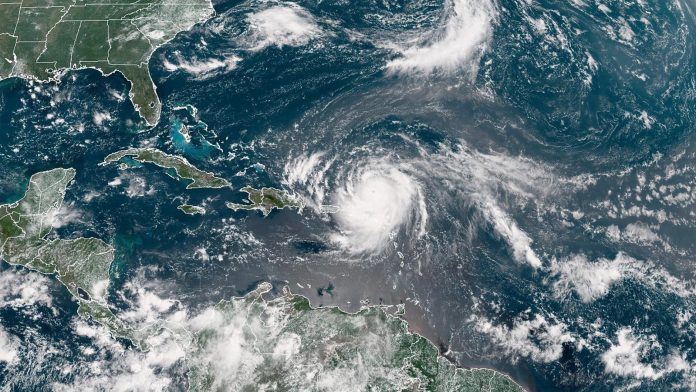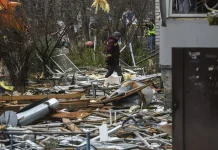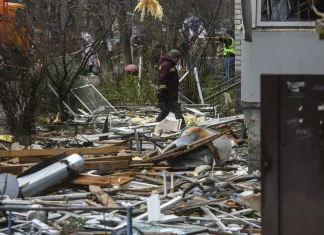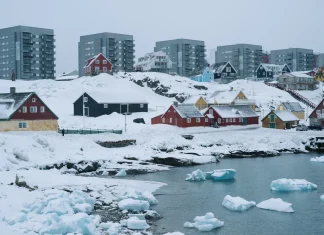Hurricane Erin: The Atlantic’s Fierce Newcomer Sends Ripples Across the Caribbean and the US Coast
There’s a palpable tension hanging in the warm Caribbean air—a quiet buzz beneath the palm fronds, the kind that whispers of nature’s immense power on full display. Hurricane Erin, a tempest born from the restless Atlantic, surged from a tropical whisper to a roaring Category 4 giant over the weekend, setting its sights near the Bahamas and Turks and Caicos. For island residents and coastal communities along the US East Coast, Erin is more than just a weather pattern; it’s a vivid reminder of the volatile dance between human life and nature’s raw forces.
The Meteorological Marvel and Menace of Erin
“Erin’s already large size and intensity are acting like a giant plunger on the sea surface,” Alex Sosnowski, a senior meteorologist with AccuWeather, remarked, capturing the sheer energy this storm wields. In meteorological terms, Erin is a spectacle—among the fastest-strengthening storms ever observed in the Atlantic basin. In just over 27 hours, it intensified dramatically from a tropical storm into a Category 5 hurricane. That’s a rare and frightening feat, underscoring 2025’s unsettling streak as the fourth consecutive Atlantic season to spawn at least one Category 5 monster.
Though Erin’s wrath has somewhat diminished, slipping just shy of the storm’s peak, it remains a formidable Category 4, with winds clocking an intense 210 kilometers per hour as it passed east of the Bahamas early Monday morning (Irish time). The US National Hurricane Center (NHC) assures us that it likely won’t make landfall on Bermuda or the US mainland, but warns it will maintain its dangerous power well into midweek.
Island Life Shaken: Turks and Caicos and the Bahamas Brace
Far from the comforting buzz of urban life, in the idyllic archipelago of Turks and Caicos — a British overseas territory renowned for its crystalline waters and laid-back charm — the mood shifted swiftly from leisurely to urgent. Authorities suspended public services on Providenciales, the largest island, issuing warnings for residents in storm-prone areas to prepare for possible evacuation. The turquoise sea, usually a playground, has turned ominous as tropical storm conditions sweep across the region.
Keen eyes on the ground tell stories of caution and care. Kate Williamson, the Southeastern District Administrator in the Bahamas, put it plainly in a recent interview with local media: “We’re asking our small communities on islands like Long Cay to mobilize and move to the mainland. Safety is paramount. The sea does not forgive.”
The Bahamas Meteorology Department corroborates this cautious approach, advising all boats to remain docked until the seas settle, warning of perilously rough swells that could imperil vessels and livelihoods alike. “The seas could become extremely rough and dangerous during the swells,” their urgent bulletin stated, a sober note in a season otherwise marked by vibrant tourism and island festivals.
North Carolina’s Outer Banks: Between Beauty and Bracing for Impact
Meanwhile, thousands of kilometers north, the US East Coast watches nervously as Erin’s turbulent energy twists along the ocean. North Carolina’s Outer Banks, a sun-drenched chain of barrier islands famous for pristine beaches and charming vacation towns, is sounding alarms. The NHC issued a Tropical Storm Watch stretching from Beaufort Inlet to Duck, with a storm surge watch active for areas including Cape Lookout.
Waves are predicted to surge as high as 6.1 meters, and rip currents could turn deadly, luring unwary swimmers into perilous undertows. “We’re dealing with a serious event here,” sighs Dare County official Lisa Weathers. “Our islands are vulnerable—low-lying, with limited evacuation routes. We’ve ordered tourists and residents to leave the flood-prone barrier islands of Hatteras and Ocracoke for their own safety.”
Those islands harbor just a few hundred permanent residents, but their fall and spring tranquility belies a much larger seasonal influx. According to the US National Park Service, approximately 2.7 million visitors journey to the Outer Banks annually, often drawn by the lure of summer’s heat and salty breezes. “It’s heartbreaking,” Weathers adds. “Many choose to stay, enamored by the islands, but they shouldn’t underestimate the danger.”
Voices from the Frontline: Stories from the Storm’s Edge
On Hatteras Island, the Atlantic Inn stands as a bulwark against the coming storm. Its owner, Holly Andrzejewski, is no stranger to these menacing skies. “We’re battening down, planning to ride this out. It’s tense, but we’re prepared,” she says, her voice steady. Alongside her husband and a small, dedicated staff, Holly intends to keep a watchful eye on the 10-bedroom inn amid the gathering rain and wind.
A little inland, on Roanoke Island, innkeeper Lee Brickhouse expresses cautious optimism. “No evacuation orders yet, but we’re being vigilant. Some guests are canceling their stays, others are hopeful that the worst will bypass us. We’re holding our breath, essentially.” His sentiment captures a widespread feeling—hope tangled with the stark reality that nature often charts its own course.
More Than a Storm: What Erin Means in a Changing Climate
Hurricane Erin is more than a headline or a weather alert—it’s a vivid symbol of a planet in flux. Experts have noted the increasing frequency and ferocity of intense Atlantic hurricanes, highlighting the sobering influence of rising sea and air temperatures fueled by climate change. Fast intensification, such as Erin’s rapid leap to Category 5 status within just over a day, is becoming increasingly common.
“Every season, the bar rises,” meteorologist Alex Sosnowski reflects. “We’re witnessing a new norm, where storms gain strength and complexity with alarming speed, leaving less time for preparation and posing greater risks for vulnerable communities.”
For residents of the Caribbean and North American coastlines, Erin is a stark reminder of their shared vulnerability—and the urgent need for resilient infrastructure, timely evacuations, and, crucially, global action to combat the climate crisis.
What Can We Learn from Erin?
As you read this, perhaps from a place miles away from turbulent seas and anxious evacuations, it’s worth reflecting: How prepared are we as global citizens for the increasing volatility of our weather? How do we balance the irresistible call of beautiful coastlines with the undeniable threat that nature’s fury can return, uninvited and unrelenting?
In the wake of storms past and Erin’s ongoing journey, communities everywhere are reminded to respect the ocean’s power, heed the warnings nature sends, and rally in support of those whose homes and lives hang in the balance. It’s a rhythm written in the tides of history but now played out with new urgency.
So, where will Erin’s story end? The tempest’s path may bend away from direct landfall, but its ripples reach far beyond. It demands we listen, prepare, and confront the larger forces shaping our future.










